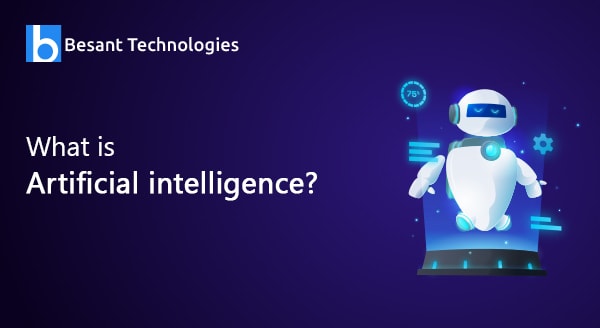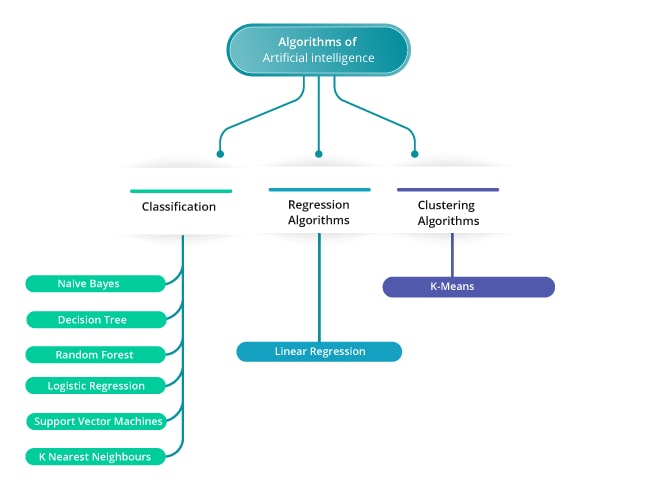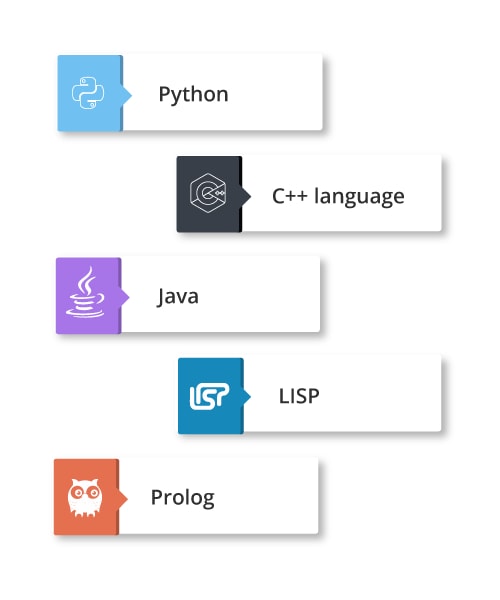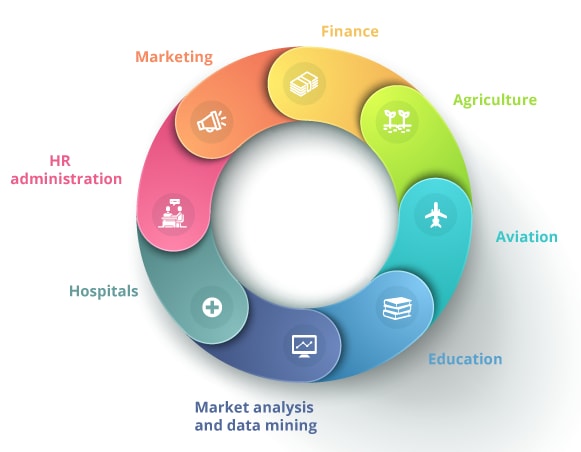
What is Artificial Intelligence?
Table of Content |
1. What is Artificial Intelligence?
Training the machines to learn from data and creating the characteristics of human intelligence is called Artificial Intelligence. Artificial Intelligence is the intellectual process to find the reason, discover meaning, learn from past, and generalize the experience. Learning, problem-solving, reasoning, and perception are the different components of artificial intelligence. Artificial Intelligence Training from Besant Technologies provides basic knowledge. The eligibility to learn this training is knowledge on maths, statistics or probability. Let us comprehend the usage of algorithms, programming languages, and performance factors to understand what is artificial intelligence?
2. Algorithms of Artificial Intelligence

The algorithms of artificial intelligence are used to solve different types of problems. The major classification of the problems is regression, classification, and clustering.
2.1 Classification
Classification is the algorithm that deals with the process of concluding the data. The classification algorithm provides limited answers like one or two and it helps the algorithm to learn from the information.
- Naive Bayes
- Decision Tree
- Random Forest
- Logistic Regression
- Support Vector Machines
- K Nearest Neighbours
2.1.1 Naive Bayes
Naive Bayes take each feature as an independent feature and it will not relate features before calculating a probability for a given event. In the case of the massive dataset, this concept gives accurate predictions as it assumes there is no relationship among the features.
2.1.3 Decision tree
The Decision tree is the process of classifying the problems. The dependent variables can be categorical or continuous. The decision tree split the group of data into two or more data sets.
2.1.4 Random forest
Random forest is the algorithm which has a collection of decision trees. Each new object is added to its attributes and the tree consist of many classes with votes.
2.1.5 Logistic regression
Logistic regression is the process of finding out discrete values among independent variables. The other name of logistic regression is logit regression.
2.1.6 Support Vector Machine
In the case of the support vector machine, the raw data is pointed as ‘n’ dimensional space. Each coordinate is tied to a value of feature which makes the process of classification easy.
2.1.7 KNN
In the KNN algorithm the cases are stored and the classification process deal with the cases according to the majority vote from K neighbors. The new cases are allotted as per the majority vote. This algorithm is used in the industry of data science to solve the problem of classification and regression. Most widely used for the classification problem.
2.2 Regression
2.2.1 Linear Regression
Linear regression is the process of creating a relationship between the dependent variables and independent variables. The linear equation which represents the regression line is Y=a*X+b. Here Y- dependent variable, X- independent variable, a-Slope, and b-Intercept.
2.3 Clustering
The Clustering algorithm is one of the mathematical equation which group the events, people, and things to get insight from the information. The basis of division for clustering is very crucial. For instance, if the group is full of humans then the division can be gender, income, hobbies, geographical location and skills. This method is very successful and Netflix is one of the companies using this algorithm for its successful operations.
2.3.1 K-Means
In K-Means the data sets are classified as per the qualities and it is easy to find the classification among data points with the cluster as homogenous and heterogeneous.
3. Human Intelligence and Artificial Intelligence
Human intelligence and artificial intelligence are interrelated by the behavior and intelligence can be grouped as per its usage. Let us take a deeper look into the different processes of artificial intelligence algorithms that work like human intelligence for taking decisions.
3.1 Learning
Trial and error is the system which leads to the process of learning through memory. The process of solving the problem and similar problems are compared to apply the intelligence. In the case of language predictions if the program is given with a set of rules to be followed and thus predict the answer. Learning is the part of artificial intelligence that learns about the solutions through experiences and rules. Two types of learning are supervised learning and unsupervised learning.
3.2 Problem-solving
The two types of methods that come under solving the problem are a general-purpose method and the special-purpose method. The special purpose is the tailored option for handling a specific situation. General-purpose problem-solving uses the inputs like a pickup, move back, move forward, move left, and move right are actions to complete the tasks.
3.3 Reasoning
There are two models that come under reasons or inferences and they are a deductive model and inductive model. The Deductive model works with assurance whereas the inductive model works without absolute assurance. Mathematics and logic deal with deductive reasoning. Intelligence is associated with reasoning and matching the reasons for the solution.
3.4 Perception
Perception analyses with sensory organs, real environment or artificial environment. If robots are trained to assemble components in vehicles like car or trail then it completes the tasks with the intelligence called perception.
4. Programming languages of Artificial Intelligence
C++, Java, python, IPL, LISP, PROLOG, and tense logic are the different programming languages used in Artificial intelligence. Out of the list if we look for the popularity of the language the resumed list goes as Java, C++, Prolog, python, and LISP.

4.1 Python
Python language is a versatile language for its simplicity of coding and interactive nature. Python supports the neural networks and NLP solutions as a part of a machine learning application. For translating text and for describing photos python libraries are used. The standard python libraries provide the process to clean the deep learning models. Deep learning methods are connected to the existing natural language systems as a replacement model to improve performance. The features of natural language are known with the help of deep learning and there is no need to extract the features using expert systems.
4.2 C++ language
C++ language is used in the different techniques of artificial intelligence. This language is suitable for the promotion of computer games, search engines as it provides fast execution, reuse of programs and less response time. As artificial intelligence is handled by non-developers it makes use of many libraries like Keras, Watson, Caffe, and Tensorflow. These libraries require languages like C++ and Python for handling load data, neural networks, launch the techniques of artificial intelligence and display results.
4.3 Java
Java is a suitable language for using NLP, neural networks and search algorithms. No need to recompile java language when using artificial intelligence. Java is easy to use, easy to debug, simple to work, manage large projects, aids for visualization, and interact better with users. Neuroph, Tensorflow, MXNet, Frank Greco of IBM and Deeplearning4j are the neural networks of java.
Seldon, Kubeflow, Amazon Pagemaker, and Mleap are the different model servers which support for machine learning. Seldon integrates the Kubernetes and machine learning model server. Kubeflow aid for ML stack on Kubernetes. Amazon Pagemaker contributes to the building, deploying and training the machine learning models. Milap is used to deploy spark and ML models.
This works as an open-source project. For Natural language processing, open NLP is the toolkit of natural language processing which provides information about API documentation with information. Stanford CoreNLP is the framework that is used for NLP tasks. SMILE is the engine that aids in processing machine learning with java.
SVM, random forest, decision trees, and gradient boosting are some of the algorithms which come under SMILE. SINGA is used for machine learning as an open-source library. RapidMiner, Weka, MOA, Encog machine learning framework, H2O, burlap, and JavaCPP are some of the frameworks which operate the machine learning algorithms with Java.
4.4 LISP
LISP is the oldest programming language that aids in artificial intelligence. LISP is dynamic and strong for handling the coding. This language aids in prototyping and research with intellectual intelligence. It is suitable for logic projects in artificial intelligence.
4.5 Prolog
Prolog is the flexible language and oldest language which aid for the development of artificial intelligence. It is a declarative language and rule-based language for coding artificial intelligence. The mechanisms which can be completed using prolog are pattern matching, automatic backtracking, and tree-based data structure.
5. Performance of Artificial Intelligence
We are into the shadow or artificial intelligence where it becomes inevitable to talk about artificial intelligence. The Global market depends upon artificial intelligence and we are seamlessly using artificial intelligence along with video games, automobiles, and smartphones. The performance of the AI can be grouped under strong and weak AI. Let us, deep-dive, into the performance aspect of artificial intelligence. The outcome is very essential and it is the basis for understanding the exact requirement of artificial intelligence.
5.1 Strong and weak artificial intelligence
Weak artificial intelligence is termed as the difference between supervised learning and unsupervised learning. In the case of unsupervised learning, the process is completed as steps in the program. Apple Siri is the best example of weak artificial intelligence. It operates with the predefined system to use the database from the internet, converse with actual people, and also offers remarks for the operations.
This is an example of weak artificial intelligence. Weak AI works accurately and robots used for the process of manufacturing is another example of weak AI. Strong AI focuses on the meanings behind data. Here the outcome is unpredictable as it is not programmed to the user request or keyword. Some games are empowered with strong AI and these AI work independently.
It is predicted that the AI market will reach $60 billion by the year 2025. By the year 2030, the AI will increase the GDP by $15.7 trillion. Since 2000 many start-ups invest in AI. It is predicted that robots along with AI will behave more like humans. 77 percent of the electronic devices that we use to operate with the concept of artificial intelligence. The salary of artificial intelligence engineers is $138, 1010 per year and there are huge opportunities for Artificial intelligence engineers in the global market.
6. Applications of Artificial Intelligence

6.1 Agriculture
For the agricultural sector AI advancements aid for understanding the processing time for the crops and application of AI techniques are known through agricultural robots. Simulation, modeling, and automation are some of the specializations with AI techniques.
6.2 Aviation
Air operations division implements AI technology with expert systems that are rule-based. Airplane simulators use the technology of artificial intelligence to process the information and guide the pilots. The traffic in the air is controlled by computer-simulated plots.
6.3 Education
Artificial intelligence is making the administrative task easy, create smart content with text, image, and video, make learning as a personalized platform with relevant content, and aid for reaching global learners on a global scale. It is predicted from one analysis that AI will increase learning by 47.5 percentage. The technology of artificial intelligence will improve the lower level of education and also higher-level education.
6.4 Market Analysis and Data Mining
In the field of the stock market, data mining is the task that makes use of artificial intelligence. The stock market is difficult to predict and the movements related to stock market aid for the prediction. AI technologies are used in the stock market to predict. The decision making trees and financial indicators will aid in the analysis of the stock market.
6.5 Hospitals
In the field of medical science artificial intelligence is used for data processing, data collection, increase healthcare-related devices, health records in an electronic system, natural language processing, and robot designed for taking care of surgery.
6.6 Human Resource Administration
In the field of human resource management for job vacancies, multiple applications will be processed. To process such applications AI is used to check the relevance with the resumes. Every sphere of administration such as onboarding, feedback, performance review, retention, and training are handled by AI technology which reduces tasks related to human resource administration.
6.7 Marketing
AI marketing is using the technology of AI for customer data and concepts related to AI. AI technology optimizes the advertisements through analyzing the customer data like social profiles, online data and keyword searches by customers.
6.8 Finance
In the finance industry AI contribute a big portion in the form of risk assessment and fraud detection. Before issuing a credit card it is essential to check the risk assessment. In such scenario AI aid for the analysis as it is data-driven. In the case of loan processing fraud detection aid for understanding the behavior of the customers. For financial decision making AI technology gives excellent balance to the business.

